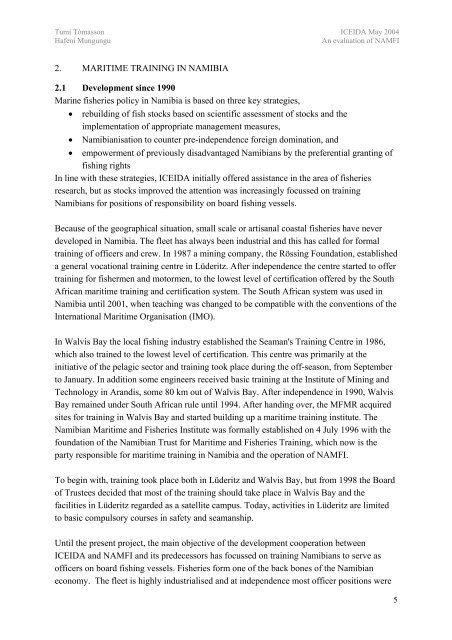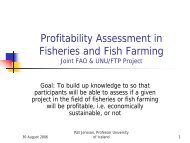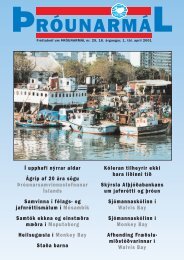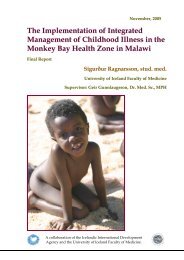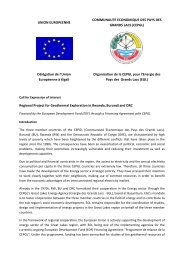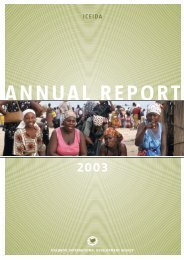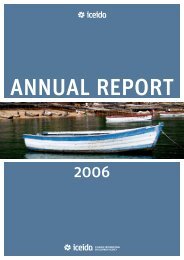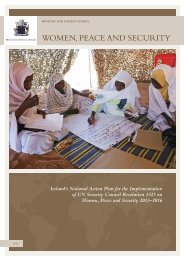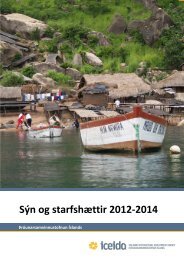An Evaluation of the NAMFI/ICEIDA Cooperation Project 2002 -2004
An Evaluation of the NAMFI/ICEIDA Cooperation Project 2002 -2004
An Evaluation of the NAMFI/ICEIDA Cooperation Project 2002 -2004
Create successful ePaper yourself
Turn your PDF publications into a flip-book with our unique Google optimized e-Paper software.
Tumi Tómasson <strong>ICEIDA</strong> May <strong>2004</strong><br />
Hafeni Mungungu<br />
<strong>An</strong> evaluation <strong>of</strong> <strong>NAMFI</strong><br />
2. MARITIME TRAINING IN NAMIBIA<br />
2.1 Development since 1990<br />
Marine fisheries policy in Namibia is based on three key strategies,<br />
• rebuilding <strong>of</strong> fish stocks based on scientific assessment <strong>of</strong> stocks and <strong>the</strong><br />
implementation <strong>of</strong> appropriate management measures,<br />
• Namibianisation to counter pre-independence foreign domination, and<br />
• empowerment <strong>of</strong> previously disadvantaged Namibians by <strong>the</strong> preferential granting <strong>of</strong><br />
fishing rights<br />
In line with <strong>the</strong>se strategies, <strong>ICEIDA</strong> initially <strong>of</strong>fered assistance in <strong>the</strong> area <strong>of</strong> fisheries<br />
research, but as stocks improved <strong>the</strong> attention was increasingly focussed on training<br />
Namibians for positions <strong>of</strong> responsibility on board fishing vessels.<br />
Because <strong>of</strong> <strong>the</strong> geographical situation, small scale or artisanal coastal fisheries have never<br />
developed in Namibia. The fleet has always been industrial and this has called for formal<br />
training <strong>of</strong> <strong>of</strong>ficers and crew. In 1987 a mining company, <strong>the</strong> Rössing Foundation, established<br />
a general vocational training centre in Lüderitz. After independence <strong>the</strong> centre started to <strong>of</strong>fer<br />
training for fishermen and motormen, to <strong>the</strong> lowest level <strong>of</strong> certification <strong>of</strong>fered by <strong>the</strong> South<br />
African maritime training and certification system. The South African system was used in<br />
Namibia until 2001, when teaching was changed to be compatible with <strong>the</strong> conventions <strong>of</strong> <strong>the</strong><br />
International Maritime Organisation (IMO).<br />
In Walvis Bay <strong>the</strong> local fishing industry established <strong>the</strong> Seaman's Training Centre in 1986,<br />
which also trained to <strong>the</strong> lowest level <strong>of</strong> certification. This centre was primarily at <strong>the</strong><br />
initiative <strong>of</strong> <strong>the</strong> pelagic sector and training took place during <strong>the</strong> <strong>of</strong>f-season, from September<br />
to January. In addition some engineers received basic training at <strong>the</strong> Institute <strong>of</strong> Mining and<br />
Technology in Arandis, some 80 km out <strong>of</strong> Walvis Bay. After independence in 1990, Walvis<br />
Bay remained under South African rule until 1994. After handing over, <strong>the</strong> MFMR acquired<br />
sites for training in Walvis Bay and started building up a maritime training institute. The<br />
Namibian Maritime and Fisheries Institute was formally established on 4 July 1996 with <strong>the</strong><br />
foundation <strong>of</strong> <strong>the</strong> Namibian Trust for Maritime and Fisheries Training, which now is <strong>the</strong><br />
party responsible for maritime training in Namibia and <strong>the</strong> operation <strong>of</strong> <strong>NAMFI</strong>.<br />
To begin with, training took place both in Lüderitz and Walvis Bay, but from 1998 <strong>the</strong> Board<br />
<strong>of</strong> Trustees decided that most <strong>of</strong> <strong>the</strong> training should take place in Walvis Bay and <strong>the</strong><br />
facilities in Lüderitz regarded as a satellite campus. Today, activities in Lüderitz are limited<br />
to basic compulsory courses in safety and seamanship.<br />
Until <strong>the</strong> present project, <strong>the</strong> main objective <strong>of</strong> <strong>the</strong> development cooperation between<br />
<strong>ICEIDA</strong> and <strong>NAMFI</strong> and its predecessors has focussed on training Namibians to serve as<br />
<strong>of</strong>ficers on board fishing vessels. Fisheries form one <strong>of</strong> <strong>the</strong> back bones <strong>of</strong> <strong>the</strong> Namibian<br />
economy. The fleet is highly industrialised and at independence most <strong>of</strong>ficer positions were<br />
5


